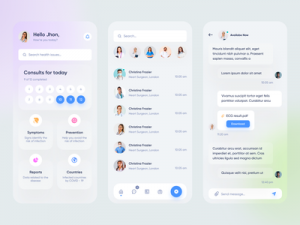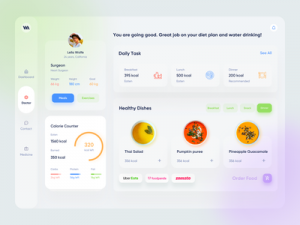#blueprint #blueprint crx
Advanced scalable with open APIs online appointment booking management, diagnostic tests, prescribing medication, follow-ups, electronic health records for practices/clinics, and hospitals.

Mobile Applications
Full IOS and Android mobile applications.
Web & OS Applications
Web, Microsoft, Linux, and Apple IOS operating system application.
Wearable & Kiosks
For a seamless integration of waiting room patient check-in operation and monitoring.
Scalable & Customizable
Blueprint fully scalable & customizable to meet any size organization with the additional development addon as require.

Percent Patient
Satisfaction Increase
Reduce costs and increase patient satisfaction by offering your own telehealth program.
Percent ROI
Increase Mothly
Hospital readmissions, lower treatment costs, and promote continuity of care that all work to enhance patient satisfaction.
Blueprint / Blueprint CRX
Telehealth software systems can cover three major types of services:
Features For:
TELEHEALTH FEATURES FOR PATIENTS
It is important to develop functional and user-centered software that will cover the patients’ needs and be oriented on their convenience and accessibility. Both healthcare providers and development teams have to anticipate customer requirements and meet them with the following functionalities.
User Profile
Besides containing general information like name, age, or address, patients need to have access to data on last visits, lab orders and results, prescriptions, treatment guides, etc. It is always great to add the search for insurance providers to check if the patient is covered or the employer section as many of them reimburse costs for video visits as well.
List of the Providers
The great search engine allows patients to find the required specialists just in a few clicks. Firstly, doctors need to be categorized by specialty, current availability, and location. It isn’t just convenient that the patient can schedule the follow-up appointment in a clinic but it can be limited by state laws like in the US. Doctors licensed in certain states can’t serve the patient from others until they get their licenses as well. Specialists’ rates via patient feedback are a great addition to improve the quality and transparency of the services.
Assessments
That is one of the nice-to-have telehealth features that helps in the pre-diagnosis stage and treatment itself. The functionality is quite diverse. As far as filling in the simple questionnaire the patient knows what specialists to contact or doctors can gather necessary data on the current patient conditions before the video visit or call. The more details the specialists gather, the more accurate diagnosis is made.
Video and Audio Calls
Real-time interaction enables medical practitioners to serve at a distance. That is an efficient solution for primary, preventative or chronic care. It is important to understand that making a call via telehealth video conferencing software is completely different from the regular telecommunication app. Each transmission is secure and HIPAA compliant as it has to be during the in-person visit.
Customer Support
It is required to provide the technical support that raises customer engagement, solves disputes between patients and doctors, conducts negotiations on service, payment, and insurance-related questions. Moreover, the development team has to find solutions to moderate software platforms including user feedback, doctors’ workload, etc. For example, tracking the visits actuality is rather important so the patients aren’t charged for canceled or missed visits and doctors aren’t paid for services that they don’t provide.
Calendar
The advanced calendar would be a great addition to the functional telehealth software system. Patients would benefit from the customized designs, synchronization with other calendars and integration with scheduling features of doctor portals. It allows users to easily find free appointment slots due to doctors’ availability, schedule calls/video visits and set automatic reminders on the upcoming events. Moreover, this app feature can become a customized tool to develop and maintain healthy habits like physical activities, the sleep schedule, staying hydrated and taking medicine on time. The more features you add the better time management tool you present for your users. One thing to remember here is being complex under the hood, it has to be clear and easy to use for patients.
Integration with other eHealth applications
If the app synchronizes with other applications, gathered data becomes a valuable source that helps medical personnel make a more accurate diagnosis. For example, HealthKit application reads and writes the health data like temperature, blood pressure, oxygen saturation, blood glucose. Permitting to share it with the primary care provider allows them to monitor patients’ conditions regularly.
TELEHEALTH FEATURES FOR PROVIDERS
In order to provide quality services for patients, medical practitioners have to be equipped with professional tools. In the case of eHealth, it is advanced software that enables connections between the involved parties. So let’s define the most common functionalities to include here.
Medical Practitioner Profile
The doctors’ profile is like a resume that would be presented to the patients and other healthcare providers. The more complete the profile is, the more professional and trusting it looks. The appropriately professional photos, past experience, licenses and certifications, best accomplishments have to be covered here. It is always a great idea to include customers’ feedback and rates.
Electronic Health Records
Like any other application for healthcare professionals, it has to be fully integrated with EHR and EMR systems. This ensures valued-based care within regulatory compliance and enables secure data exchange with patients, third-party providers like pharmacies, insurance services, health registries, etc. For example, doctors can get access to the disease history, previously prescribed treatments, reports on patients’ lab test results, health improvement data gathered by other eHealth applications.
Scheduling
Using in-build features, the physicians are able to manage their timetable, schedule calls and video visits, track working hours, etc. Integration with Google Calendar, iCalendar or other time management apps advances the overall app functionality. Automated reminders allow doctors to be on schedule everywhere and inform patients about open hours to book the appointments. Moreover, telehealth software systems can gather data on the busiest hours to offer better specialists’ availability.
Video and Audio Calls
Remaining the main feature of any telehealth software system, it targets at establishing direct communication between doctors and patients through HQ Audio or/and HQ Video. The development team also has to implement video and audio recordings, hosting features. Besides, it is essential to provide good video compression to save the Internet traffic or dial-in numbers to connect via voice using the regular phone. Quite often during the call, the medical personnel needs access to doctor’s notes, medical protocols, and calculators, treatment guidance. Considering that fact, the additional functionality is a necessity to consult patients on the highest level.
Prescription
It is a common practice to suggest complete drug info, brand, pricing, the closest pharmacies with available medicine. Once the ePrescription is written, it can be shared with both patients and pharmacy services. Nevertheless, all the prescriptions have to comply with the necessary regulations. For example, the ePrescription for controlled substances like codeine is forbidden as it is only done after visiting the doctor in person.
Remote Patient Monitoring
The advanced telehealth features bring together many connected tools to deliver higher quality care services. A centralized repository gathers the patients’ data via sensors, wearables or other synchronized apps to process and share with healthcare providers. It enables improved support, daily awareness of patients’ condition as well as emergency prevention. Ensuring better patient and doctor engagement is the main target of any healthcare system.
Account Moderation and Support
Medical practitioners are usually granted additional permissions to perform actions. Account moderation and support would help to build good relationships within the app community. For example, doctors also have the ability to moderate the chats. It can cover no posting from guests only signed-in users, limited history and embed access, denied permissions to post messages or share images, Sometimes it even ends up blocking certain users. However, it could prevent policy violations and solve arising disputes.
Continuous Medical Education
An extremely helpful tool can include different case studies, practice-changing updates as well as share experience with doctors that use the same software. In other words, it’s building the progressive and supportive community within your app. For example, the telehealth software development team can include the internal chat for medical specialists to share the first-hand experience or quick mass mailing update about some new methodology or medicine.






Let’s collaborate
Blueprint is fully scalable
and customizable platform.
Telehealth software development isn’t just growing in popularity but becomes the absolute necessity of today’s healthcare. It gives access to efficient and affordable care services. About 74% of US citizens are interested in receiving healthcare via software systems. Those who have already used it acknowledge good quality or even better than in-person visits whereas the cost remains lower.
In their turn, healthcare providers invest in telehealth software development that can meet specific user needs and compliance regulations, including security. Taking the example of the Doctor On Demand app, we’ll discuss what challenges can be solved, common features for these software platforms, and compliance regulations.

